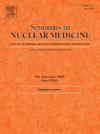Advances of PET/CT in Target Delineation of Lung Cancer Before Radiation Therapy
IF 5.9
2区 医学
Q1 RADIOLOGY, NUCLEAR MEDICINE & MEDICAL IMAGING
引用次数: 0
Abstract
In the clinical management of lung cancer, radiotherapy remains a cornerstone of multimodal treatment strategies, often used alongside surgery or in combination with systemic therapies such as chemotherapy, tyrosine kinase inhibitors, and immune checkpoint inhibitors. While conventional imaging modalities like computed tomography (CT) and magnetic resonance imaging (MRI) continue to play a central role in staging, response assessment, and radiotherapy planning, advanced imaging techniques, particularly [18F]FDG PET/CT, are being increasingly integrated into routine clinical practice. These advanced techniques address the limitations of standard imaging by providing insight into molecular and metabolic tumor characteristics, enabling precise tumor visualization, accurate target volume delineation, and early treatment response assessment. This review examines the role of radiotherapy in the multidisciplinary management of lung cancer, detailing current concepts of morphological and functional imaging for staging and treatment planning. It also highlights the growing importance of PET-based radiotherapy planning, emphasizing its contributions to target volume definition and predictive value for treatment outcomes. Recent methodological advances, including the integration of artificial intelligence (AI), radiomics, technical innovations, and novel PET ligands, are discussed, highlighting their potential to improve the precision, efficacy, and personalization of lung cancer radiotherapy planning.
PET/CT在肺癌放射治疗前靶区定位中的研究进展。
在肺癌的临床管理中,放疗仍然是多模式治疗策略的基石,通常与手术一起使用或与全身治疗(如化疗、酪氨酸激酶抑制剂和免疫检查点抑制剂)联合使用。虽然计算机断层扫描(CT)和磁共振成像(MRI)等传统成像方式继续在分期、反应评估和放疗计划中发挥核心作用,但先进的成像技术,特别是[18F]FDG PET/CT,正越来越多地融入常规临床实践。这些先进的技术通过提供对肿瘤分子和代谢特征的深入了解,解决了标准成像的局限性,实现了精确的肿瘤可视化,准确的靶体积描绘,以及早期治疗反应评估。本文综述了放射治疗在肺癌多学科治疗中的作用,详细介绍了形态学和功能影像学对分期和治疗计划的当前概念。它还强调了基于pet的放射治疗计划日益增长的重要性,强调了其对靶体积定义和治疗结果预测价值的贡献。讨论了包括人工智能(AI)、放射组学、技术创新和新型PET配体在内的最新方法学进展,强调了它们在提高肺癌放疗计划的准确性、有效性和个性化方面的潜力。
本文章由计算机程序翻译,如有差异,请以英文原文为准。
求助全文
约1分钟内获得全文
求助全文
来源期刊

Seminars in nuclear medicine
医学-核医学
CiteScore
9.80
自引率
6.10%
发文量
86
审稿时长
14 days
期刊介绍:
Seminars in Nuclear Medicine is the leading review journal in nuclear medicine. Each issue brings you expert reviews and commentary on a single topic as selected by the Editors. The journal contains extensive coverage of the field of nuclear medicine, including PET, SPECT, and other molecular imaging studies, and related imaging studies. Full-color illustrations are used throughout to highlight important findings. Seminars is included in PubMed/Medline, Thomson/ISI, and other major scientific indexes.
 求助内容:
求助内容: 应助结果提醒方式:
应助结果提醒方式:


